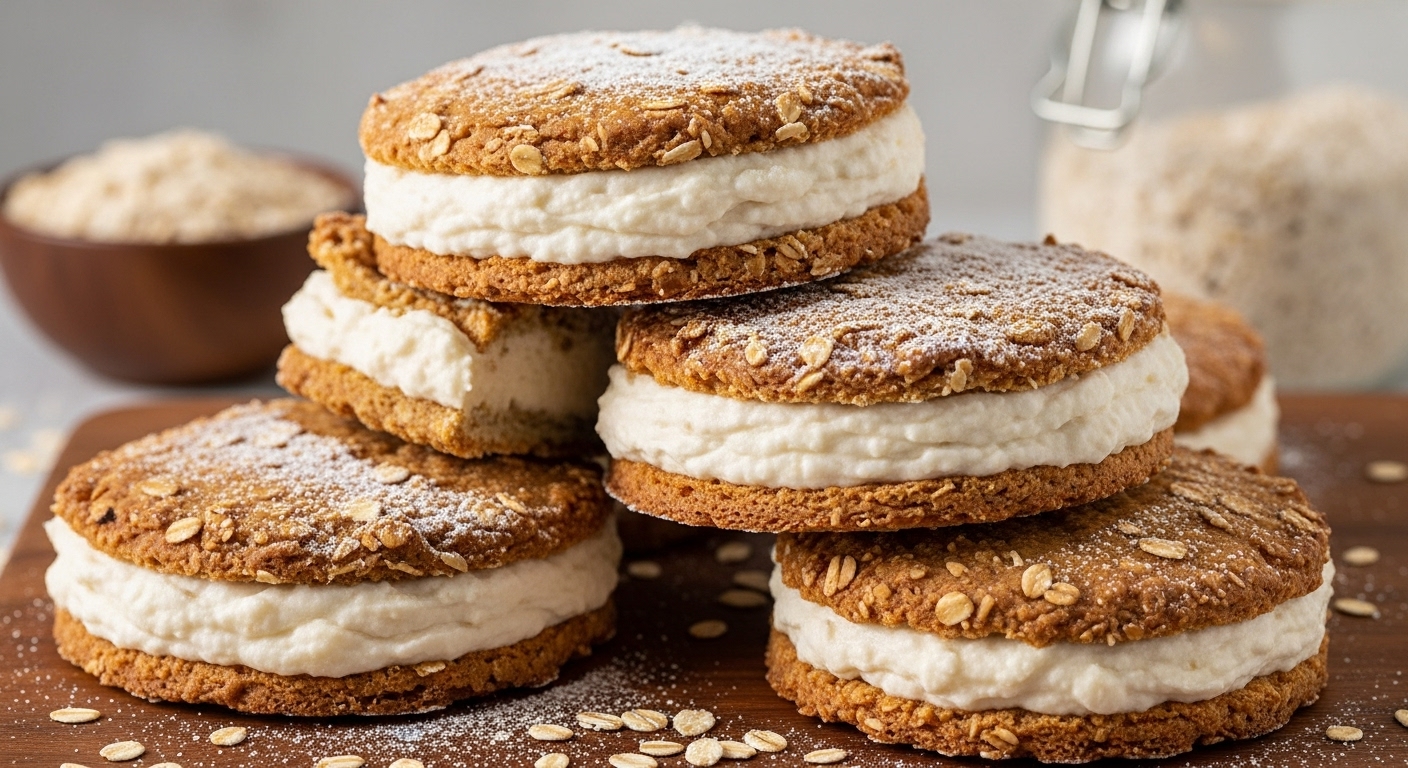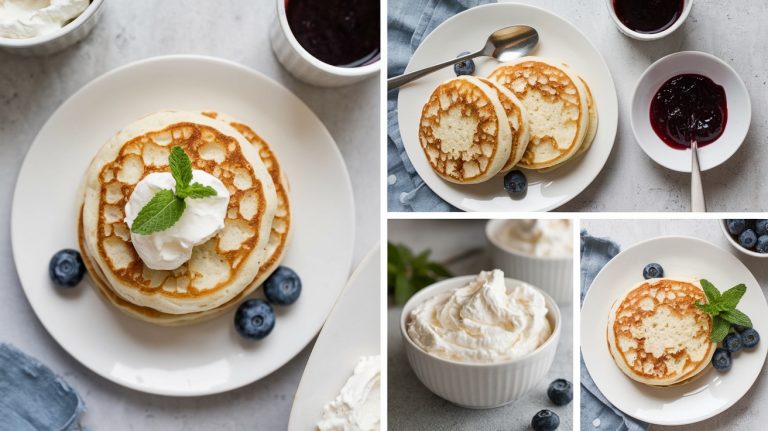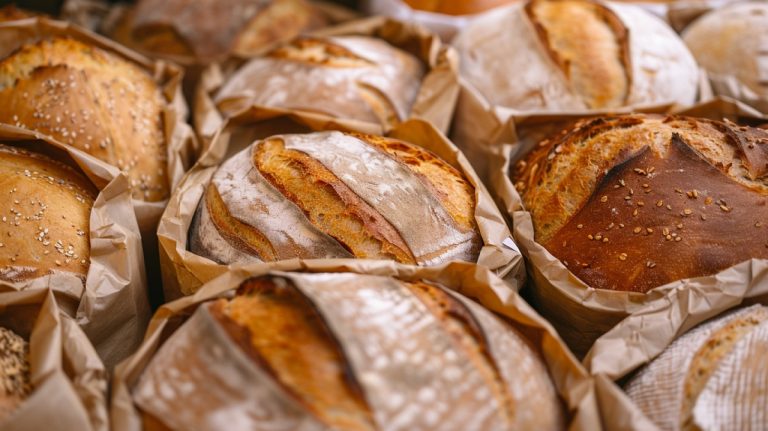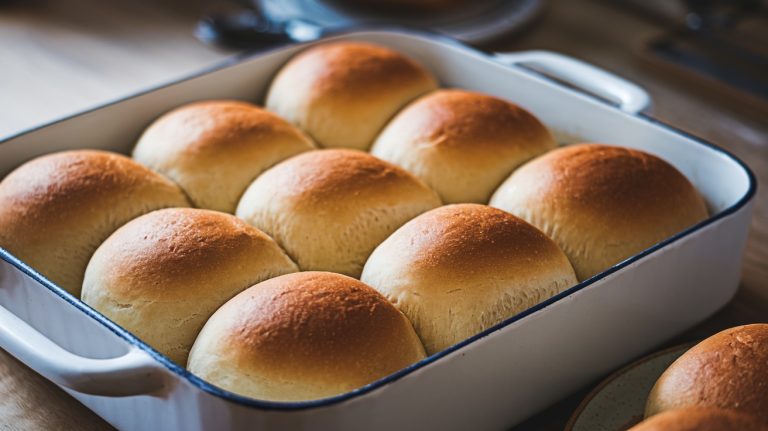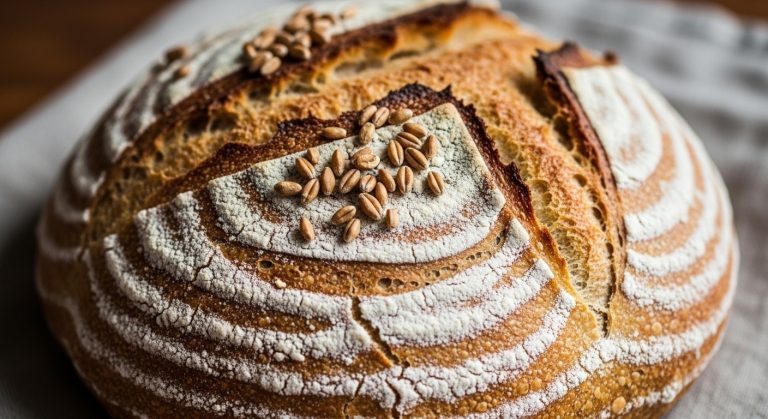Sourdough Oatmeal Cream Pies: Bakery-Level Flavor, Right at Home
You’ll create sourdough oatmeal cream pies by blending a tangy sourdough discard into a chewy cookie dough made from oats, all-purpose flour, butter, brown sugar, and warm spices for depth and structure.
After chilling, bake at precise temperatures until edges are golden but centers remain soft. Then, craft a spiced, creamy filling using softened butter and powdered sugar, ensuring smooth texture and balance.
Keep cookies cool and store properly for lasting freshness. Follow these steps closely for best results and discover how to perfect every phase.
Key Takeaways
- Sourdough oatmeal cream pies use all-purpose flour, rolled oats, and sourdough starter for chewy, flavorful cookie bases with subtle tang.
- The cookie dough is chilled for at least two hours to enhance flavor, texture, and baking consistency before baking at 350°F.
- Cream filling combines softened butter or cream cheese with powdered sugar, vanilla, and spices like cinnamon for a smooth, complementary flavor.
- Cookies must cool completely on wire racks before filling to prevent sogginess and maintain the pies’ chewy texture.
- Store filled pies airtight at room temperature for 2 days or refrigerated for 3–5 days; freeze for up to 2 months if needed.
Complete Recipe for Homemade Sourdough Oatmeal Cream Pies
| Component | Ingredients | Quantity | Notes / Purpose |
|---|---|---|---|
| Cookie Base | All-purpose flour | 150–210 g (1¼–1¾ cups) | Structure & chewiness |
| Rolled oats | 135–225 g (1½–2½ cups) | Nutty texture & depth | |
| Butter (salted or unsalted) | 113–226 g (½–1 cup) | Richness & moisture | |
| Brown sugar | 100–300 g (½–1½ cups) | Caramel sweetness | |
| Molasses (optional) | 15–30 ml (1–2 tbsp) | Deep flavor notes | |
| Sourdough starter (discard) | 120–480 g (½–2 cups) | Tangy flavor & leavening | |
| Eggs | 1–2 large | Binding & richness | |
| Vanilla extract | 5–10 ml (1–2 tsp) | Aromatic flavor | |
| Baking soda | 5 g (1 tsp) | Leavening agent | |
| Salt | 2–4 g (½–¾ tsp) | Flavor enhancer | |
| Cinnamon, cloves, allspice, nutmeg | To taste | Warm spice aroma | |
| Cream Filling | Butter or cream cheese | 113 g (½ cup) | Smooth base |
| Powdered sugar | 250–300 g (2–2½ cups) | Sweetness & texture | |
| Vanilla extract | 5 ml (1 tsp) | Flavor | |
| Milk or cream | 15–30 ml (1–2 tbsp) | Adjust consistency | |
| Cinnamon (optional) | Pinch | Spice accent | |
| Baking & Assembly | Oven temperature | 350°F (177°C) | Even baking |
| Chill time for dough | 2+ hours | Flavor & texture development | |
| Baking time | 8–12 minutes | Golden edges, soft centers | |
| Cooling | Until fully cooled | Prevents soggy filling | |
| Storage | Airtight container | — | Maintain freshness |
| Refrigeration | 3–5 days | Prolonged shelf life | |
| Freezing | Up to 2 months | Wrap tightly |
Ingredients and Flavor Components
Although sourdough oatmeal cream pies rely on familiar baking staples like flour, butter, and sugar, their unique flavor and texture emerge from the careful balance and selection of ingredients.
You’ll use all-purpose flour (150-210g) and rolled oats (135-225g) to achieve a chewy yet structured base. Incorporating oats contributes to a denser and nuttier texture, similar to whole-wheat sourdough breads.
Butter, either salted or unsalted (113-226g), provides richness. Brown sugar (100-300g) and molasses deepen sweetness with caramel notes.
The sourdough starter (120-480g) introduces subtle tang and complexity, acting as both flavor and leavening agent. This recipe also avoids artificial ingredients such as corn syrup, ensuring a more natural and wholesome dessert experience avoids artificial ingredients.
Warm spices—cinnamon, cloves, allspice, and nutmeg—add layered aromatics. For texture, baking soda aids leavening, while salt enhances flavor. The cream filling combines softened butter, powdered sugar, vanilla, and optionally cream cheese, balancing sweet and tangy profiles. Each ingredient’s precise quantity and role are critical to the final sensory outcome.
Preparing the Cookie Dough
When preparing the cookie dough, you’ll start by creaming softened butter with both brown and granulated sugars to create a smooth, aerated base essential for texture.
Then, incorporate sourdough discard, eggs, and vanilla extract to enhance moisture and flavor complexity. This sourdough base can also contribute to a lower glycemic index, making the cookies a somewhat healthier treat.
You’ll carefully blend dry ingredients—flour, oats, baking soda, salt, and warm spices—ensuring even distribution.
Fold dry ingredients into wet just until combined to avoid toughening.
Key steps include:
- Precise creaming to develop structure without overmixing
- Using oats for chew and texture variation
- Controlling mixing to maintain dough softness and scoopability
Chill the dough for at least two hours to firm up, which improves handling, flavor development, and baking consistency.
Using browned butter instead of regular butter adds a warm, nutty flavor that elevates the overall taste of the cookie dough.
Crafting the Cream Filling
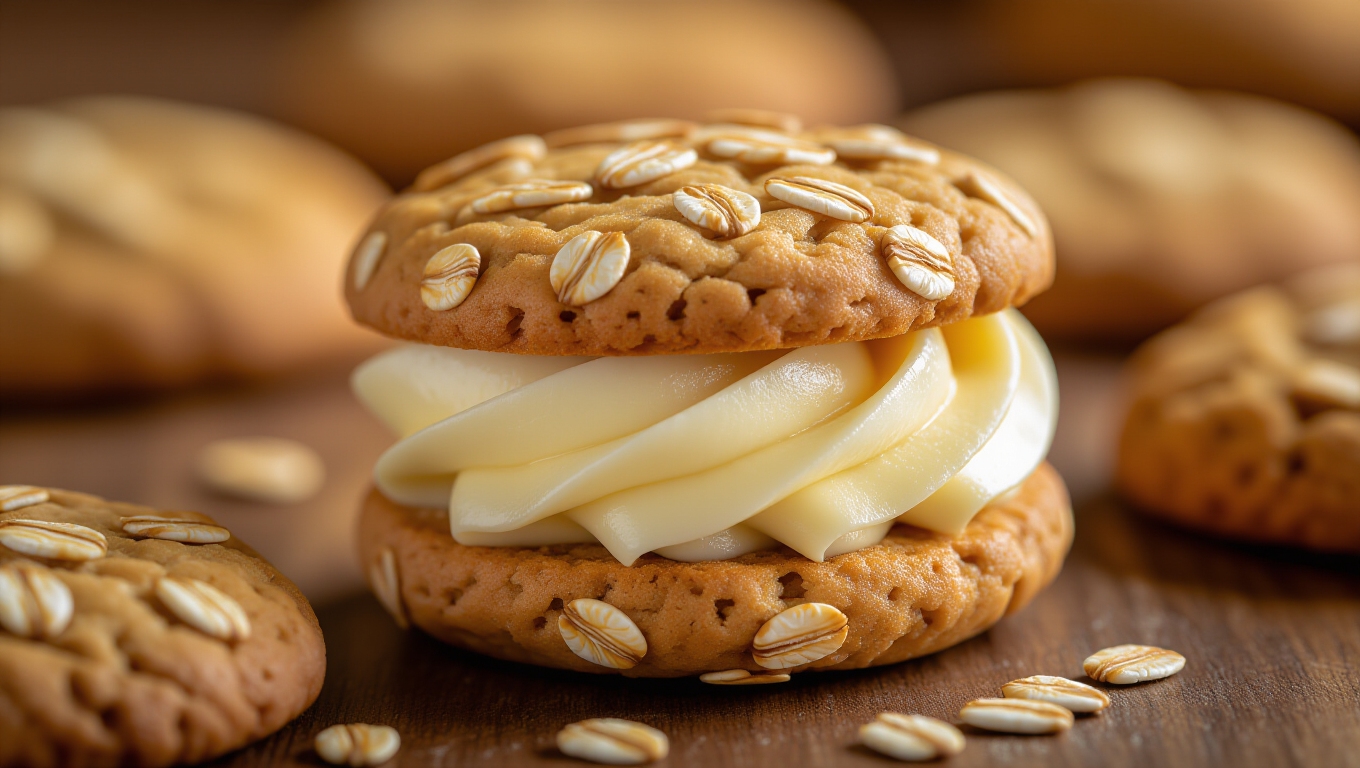
Once your cookie dough has chilled and developed its flavors, you’ll turn attention to crafting the cream filling, which balances texture and taste in your oatmeal cream pies.
Begin by softening butter or cream cheese to room temperature—this prevents lumps and ensures a smooth base. Sift powdered sugar to eliminate clumps, then beat it with your fat and vanilla extract to incorporate air, increasing volume and lightness.
Gradually add milk or cream to adjust consistency, aiming for a filling thick enough to hold shape yet soft enough to bite easily. Consider spices like cinnamon to complement your cookies.
For brown butter frosting, carefully brown and cool butter before mixing to preserve texture. Each ingredient’s role—from butter’s structure to vanilla’s flavor complexity—is critical for an ideal cream filling.
To ensure consistent results in your baking process, using a precision baking scale to measure your ingredients accurately is highly recommended.
Baking and Assembly Tips
To achieve consistent texture and flavor in your sourdough oatmeal cream pies, you’ll need to carefully manage dough preparation, baking conditions, and assembly steps.
Start by refrigerating your dough for at least two hours to firm it up, ensuring uniform cookie shape and texture. This resting period also allows the flavors to develop and the sourdough starter fermentation to enhance digestibility.
Bake cookies at 350°F (177°C), rotating sheets halfway to address uneven heat. Look for lightly golden edges and soft centers—overbaking risks dryness.
Focus on these key points:
- Use a 2-tablespoon scoop and flatten dough balls gently for uniform thickness and even baking.
- Cool cookies completely on wire racks before filling to prevent melting or sogginess in the cream layer.
- Rotate baking sheets midway for consistent heat exposure and cookie doneness.
Storage and Serving Suggestions

Although sourdough oatmeal cream pies deliver ideal taste and texture fresh from assembly, their quality depends heavily on proper storage methods. Store filled pies in airtight containers at room temperature up to 2 days to maintain softness, but expect rapid softening due to cream moisture.
Using a airtight container is essential to preserve freshness and prevent contamination. Choosing containers with ergonomic handles can also make handling and storage more convenient.
For longer shelf life, refrigerate filled pies 3–5 days, wrapped tightly to prevent drying and odor absorption; allow 1 hour at room temperature before serving to restore perfect texture. Unfilled cookies should be stored separately in glass or metal containers to preserve crispness.
Freezing assembled pies extends shelf life to 1–2 months; wrap securely to avoid freezer burn and thaw overnight in the fridge. Serve at room temperature to enhance the soft, chewy texture, pairing well with cold milk or hot beverages for a balanced sensory experience.
Frequently Asked Questions
Can I Use Gluten-Free Oats or Flour in These Cream Pies?
You can absolutely use gluten-free oats or flour, transforming your baking experience into a precise science experiment without sacrificing flavor or texture. Certified gluten-free oats, especially quick oats, deliver ideal chewiness.
While gluten-free 1:1 baking flour with xanthan gum guarantees structure and prevents spread. Just chill your dough to control consistency.
How Does Sourdough Starter Affect the Cookie Texture?
When you incorporate sourdough starter into cookie dough, it increases moisture and fermentation byproducts, resulting in a softer, cakey texture. The starter’s hydration affects dough consistency, often requiring adjustments to fat and liquid ratios to prevent excessive spread or cakiness.
It replaces some flour and water components, supporting structure while promoting tenderness. You’ll notice a denser crumb with subtle tang and complexity, but careful balancing prevents overly sour or flat cookies.
What Alternatives Exist for Brown Sugar in the Recipe?
You can substitute brown sugar with white sugar plus maple syrup, molasses plus white sugar, or use granulated maple sugar for similar moisture and flavor.
Alternatively, coconut sugar or muscovado sugar offer dry, unrefined options, though they affect moisture and texture differently.
Remember to adjust liquids or fats when using drier substitutes.
Coarse sugars like turbinado or date sugar may cause grittiness, so consider texture impact carefully before deciding.
Is It Possible to Freeze the Assembled Cream Pies?
Yes, you can freeze assembled cream pies effectively. Wrap each pie tightly in plastic wrap to prevent moisture loss and freezer burn, then place them in a sealed freezer bag or airtight container for additional protection.
This method maintains quality for up to 1 to 3 months. Expect slight texture changes in the cream filling after thawing, but the flavor remains stable.
Thaw at room temperature for best results and avoid refreezing.
Can I Replace Butter With a Dairy-Free Substitute?
Did you know that vegetable shortening matches butter’s fat content closely, making it ideal for baking? Yes, you can replace butter with dairy-free substitutes like vegetable shortening or vegan butter sticks in equal amounts without altering your recipe.
Just soften vegan butter sticks before use and measure oils accurately if substituting melted butter. Keep in mind that options like coconut oil may subtly affect texture and flavor, so choose based on your desired outcome.
Sourdough Magic Meets Creamy Bliss
By mastering the sourdough oatmeal cream pies, you harness complex fermentation and precise ingredient balance to elevate texture and flavor. Your dough’s tanginess contrasts perfectly with the creamy filling’s sweetness, creating a harmonious bite that’s nothing short of revolutionary for classic treats.
With exact baking times and temperatures, you guarantee peak crumb and consistency. Store them properly to maintain freshness and texture, guaranteeing every bite delivers a flavor explosion that could rival the best bakery results.

